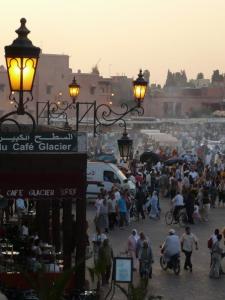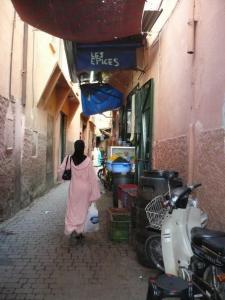The streets of Tangier were oddly quiet that morning. Empty tables and chairs lined the normally packed street side cafes. Eager street merchants looking for a sale didn’t appear until late morning and taxis were hard to find.
We had witnessed many contrasts during our trip to Morocco, this morning was just one more. From the blue ocean waves and the gentle breeze of the Pacific and Mediterranean to the dry scorching Sahara desert, from Berber tribes to a Spanish-speaking population in the north, there was never a dull moment in our two-week trip to the North African continent.
The lull in street life on the first morning of Ramadan was somewhat of a welcome change to the hectic life we had seen, but with only a few days left in our trip, we had perhaps unwisely designated this morning as one of our final shopping trips. Regardless, we walked into one of the few stores open at mid-morning, disturbing a young man reading the Koran. He was nonetheless quick to show us the array of fake watches, all at bargain prices. Twenty minutes later, my husband left pleased with a Mont-Blanc replica. Meanwhile, I happily noticed that many of the stores in the market were beginning to open. Despite the religious holiday, business, although somewhat slowed, still went on.
We shopped to our heart’s content for the next few hours, driving hard bargains with the locals. For the remaining days in Morocco, my husband and I wanted to lounge in the small beach town of Ashilah, 45 minutes south of Tangier, without having to think about souvenirs and gifts.
Our two-week vacation had started on the beach in the southern town of Agadir, filled with European tourists, and to a lesser extent Moroccans, on package holidays. After three days of miles of fine sand beach and relaxing around the pool, we were ready for a change in scenery. A five-hour bus ride took us to the central Moroccan city of Marrakech, far away from the serene beaches and scenery of Agadir. Greeted by a blast of 45 degree heat, blaring horns, and unending questions and offers by locals, the tranquility of the previous few days was forgotten as soon as we stepped off the bus.

 Djeema El-Fna Square
Djeema El-Fna Square
The "red city" so called because of the color of its walls, is one of Morocco’s most exciting and well known parts. It boasts Morocco’s largest traditional souq, market, Africa’s largest plaza, Djeema El-Fna Square and the impressive 70-meter tall Koutoubia mosque.
The many spectacles in Marrakech will constantly advert your attention to one and the other, most notably when you are wandering through the market or its famous central plaza. The strong energy and excitement, not to mention the shopping, kept us in these two spots for several hours at a time, returning almost daily during our stay there.
The market’s endless alleyways are lined with every souvenir imaginable and the throbbing pace of the market will leave you both exhausted and fascinated. Shopping in Marrakech requires a skill all its own. Be prepared for the constant badgering as any type of eye contact or glance at an item is immediately thought of as a sale. Needless to say, window shopping is not an enjoyable pastime. Once too often we ended up escaping from a vendor, only to be chased down sometimes two or three blocks from the store with an offer we couldn’t refuse. It was exhausting. When our feet couldn’t take it anymore, we found our way, along with many other tourists, to one of the numerous roof-top terraces facing the plaza.
Once the sun starts to set, Djeema El-Fna Square vibrates with an energy and pulse unlike perhaps any other place on earth. Snake charmers, musicians, fortune tellers, food stalls, story-tellers, acrobats, and potion makers, fill the massive square under a cloud of smoke produced by the many brewing delicacies: steaming snails, brochettes, couscous, sheep’s head, tea and the traditional Moroccan soup, harira.

 Alley scene in Marrakech medina
Alley scene in Marrakech medina
It is hard to find a moment of relaxation in Marrakech, but the city’s central location allows for a wide variety of trips to the diverse surrounding areas. The spectacular High Atlas mountains offer amazing trekking opportunities, and beyond the white-capped mountains, lies the endless Sahara desert and camel treks. Palm groves, lush valleys, and waterfalls are found within a days travel, and make for a great break from the chaos of the city. Within the city, a great place to get away from it all is at one of the numerous hammans or cool hotel pools.
Our backpacks now packed to the brim, we departed for Tangiers. Arriving late at night, we strolled the promenade and breathed in the refreshing sea air. The next morning we woke up to discover a cosmopolitan, diverse, Spanish-speaking city, more similar to Europe than Africa. Over the next few days we explored its numerous cafes and surroundings. Coastal villages line the Mediterranean; driving inland takes you to the dramatic Rif Mountains and Chefchaouen – a village not to be missed. It is enchanting with a medina painted entirely in a beautiful blue; gives one the sensation of being submerged underwater.
We left with wonderful souvenirs, memories and unique moments. The country’s many faces would take a lifetime to explore, but discovering a few corners of this exhilarating country, will leave you charmed.
Now back home, one of my most treasured relics hangs from my neck: the hand of Fatima. The five fingers pointing downward are said to protect against the evil eye. It is hung on many homes and buildings in Morocco and in many parts of the Muslim world. A vast array of pendants and key chains are found in any market, which made my search for the perfect one all the more difficult. I found it in a small jeweler’s shop outside the main market area of Marrakesh. Despite having paid double the price of the ones in the market, I left happy. It is my reminder of our time spent in this mystical land; a reminder of the spiritual and proud jeweler who took the time to explain its significance, along with many other mysteries of the Muslim world. If it helps to avert the evil eye, then that’s a bonus.
As for my husband’s “Mont-blanc”, it now lays on the dresser, its hands standing still.